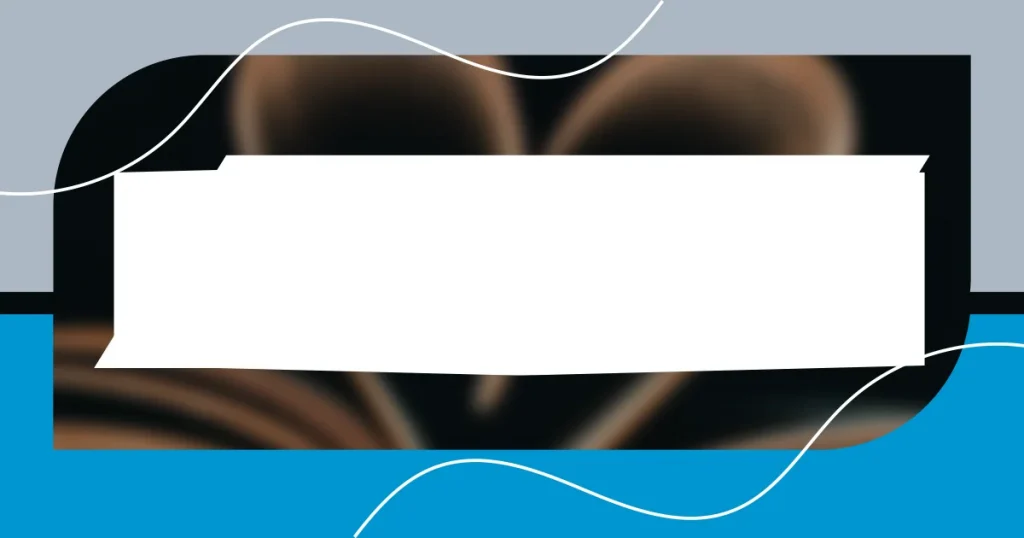Key takeaways:
- Openings in fiction are crucial as they create emotional connections, set the tone, and establish intrigue, engaging readers right from the start.
- Effective techniques for captivating openings include striking imagery, compelling dialogue, and raising unanswered questions that prompt curiosity.
- Relatable characters and their struggles enhance reader engagement, making the narrative feel personal and resonant with the audience’s own experiences.

Understanding the power of openings
When I think about the openings of a book, I can’t help but remember the first time I cracked open “The Night Circus.” The way the author painted vivid imagery in those first lines pulled me into an enchanting world almost instantly. I often wonder, what is it about those carefully chosen words that create such a strong connection?
Openings serve as a promise; they set the stage for what’s to come. They offer a glimpse into the narrative’s heart and soul, drawing you in with questions or emotions that linger long after the first read. For me, the thrill of starting a new book lies in that sweet anticipation—will this be the journey I’m willing to invest in?
I’ve found that a captivating opening is not just about intrigue; it’s about resonance. Those initial sentences have the power to echo my own experiences, making me feel seen and understood. I recall the first page of “Pride and Prejudice,” where Elizabeth Bennet’s wit leaped off the page. It’s this blend of personal connection and narrative hook that defines the magic of an opening. What resonates with you when you first engage with a new story?

Elements that engage readers
When I dive into a new story, the emotional landscape crafted in the opening is what often grips me first. I can’t forget the moment I opened “The Hunger Games” and felt the urgency rush through me as Katniss volunteer to take her sister’s place. It was that blend of high stakes and raw emotion that captured my attention right away. How often do we connect with characters who face life-altering choices in those first few sentences?
Imagery plays a crucial role in cementing that connection. I reflect on the lyrical opening of “The Ocean at the End of the Lane,” where Neil Gaiman’s descriptions evoked feelings of nostalgia and wonder all at once. It felt as if I was gazing through a window into a world both familiar and strange. What a unique feeling it is to be swept away by vivid visuals!
Dialogue can also be a powerful element in engaging readers. I remember the spark I felt during the opening lines of “A Court of Thorns and Roses,” where the characters’ banter quickly established a dynamic relationship. It pulled me into their world so effortlessly. Isn’t it amazing how a simple exchange can instantly make us care about characters and their fates?
| Element | Example |
|---|---|
| Emotional Connection | Katniss volunteering in “The Hunger Games” |
| Imagery | Descriptions in “The Ocean at the End of the Lane” |
| Dialogue | Banter in “A Court of Thorns and Roses” |

Building intrigue from the start
Building intrigue from the start is an art that can transport readers into another world almost instantly. I still remember the opening line of “1984”—it struck a chord with its starkness. It made me ponder the weight of a society under constant surveillance. Those initial words sparked my curiosity and had me contemplating deeper questions about freedom and privacy. The author, George Orwell, knew how to encapsulate a theme in just a few sentences, which is a skill I deeply admire.
To create that sense of intrigue, several techniques come into play:
- Unanswered Questions: The opening should raise questions that beg for answers. For example, “What was the mystery behind the locked room?”
- Unusual Situations: Starting with an unexpected scenario can be captivating. Think of “The Girl with the Dragon Tattoo” and the intrigue that surrounded Lisbeth’s character.
- Emotional Stakes: Conveying a character’s emotional conflict right from the start pulls the reader in, making their struggle relatable. “Where could she possibly run, with everything she loved at risk?”
Each of these elements can serve as a hook that encourages readers to flip the page.

Creating relatable characters early
Creating relatable characters early in a story is essential for drawing readers in. When I read the opening lines of “Little Fires Everywhere” by Celeste Ng, I was immediately struck by the complex family dynamics presented. It reminded me of my own upbringing, with its familiar arguments and unspoken tensions, making the characters feel like people I knew or even like my own family. Don’t you find that those nuances make a character instantly relatable?
I’ve noticed that small details can make a big difference in how we connect with characters. For instance, in the beginning of “Eleanor Oliphant Is Completely Fine,” the protagonist’s quirks and day-to-day habits painted a vivid picture of her life. I felt a pang of empathy as I recognized my own rituals in her routine. It’s fascinating how these tiny traits can create a bridge between the reader and the character’s experiences, right?
When authors introduce characters with relatable struggles, it resonates on a deeper level. I still recall how the sense of loss in “The Fault in Our Stars” pulled at my heartstrings from the very first page. Hazel’s battle with cancer made me reflect on my own fears and those of people I care about. It raises an important question: how can we ignore characters that mirror our own vulnerabilities?

Setting the tone and atmosphere
Setting the right tone and atmosphere in fiction is crucial for immersing readers in the story. I often reflect on how the moody descriptions in the opening of “The Road” by Cormac McCarthy painted a bleak yet haunting picture that lingered with me. The stark landscapes and the somber tone not only set the stage for the narrative but also evoked an emotional response—I felt a palpable sense of despair that made the journey feel real and urgent.
When I dive into a book, I appreciate how an author uses subtle cues in the environment to create an atmosphere that resonates with the themes of the story. For instance, I remember reading the early pages of “The Night Circus” by Erin Morgenstern, where the enchanting yet mysterious ambiance drew me in. The way the circus appears only at night wraps you in a curtain of intrigue, making you wonder what secrets lie beneath its surface. It’s that balance of beauty and danger that the author crafts so well, inviting readers to lose themselves in a world brimming with possibilities.
The atmosphere can also mirror the protagonist’s internal landscape, which is something I find incredibly effective. In “The Bell Jar” by Sylvia Plath, the oppressive tone and dreary descriptions closely reflected Esther’s mental state, making her struggles almost palpable. This alignment not only creates a bond between the reader and the character but also stimulates profound empathy. How powerful is it when the environment echoes our emotions, pulling us deeper into the story? That connection makes the reading experience unforgettable.

Techniques for strong openings
One technique I find particularly effective for strong openings is the use of striking imagery. When an author begins with vivid descriptions, it can spark my imagination instantly. Take “The House on Mango Street” by Sandra Cisneros, for example. The opening lines conjure up such detailed visuals of the neighborhood that I felt transported, as if I were walking those same streets. How often do we lose ourselves in such imagery right from the start?
Another tool that resonates deeply with me is dialogue. I remember reading “To Kill a Mockingbird,” where the sharp and engaging exchanges between Scout and her father captured my attention immediately. It created an intimacy that made me feel like part of their world. Engaging dialogue can not only reveal character traits but also set the narrative’s pace from the get-go. Don’t you think a well-crafted conversation can make a story feel alive before you even reach the first chapter?
Finally, I believe in the power of a compelling question or statement at the beginning of a story. This tactic pulls me in and provokes thought right away. For instance, when the opening line of “1814: The Year That Shook the World” posed, “What if everything you knew was turned upside down?” I felt a rush of curiosity flood over me. Such provocative openings create a strong sense of urgency and engagement—it’s like a call to action for the reader. Who wouldn’t want to dive headfirst into a narrative that challenges their perspective from the first moment?

Examples of captivating fiction openings
When I think about captivating fiction openings, one that stands out is the unforgettable first line of “A Tale of Two Cities” by Charles Dickens: “It was the best of times, it was the worst of times.” This duality fascinated me immediately; it paints such a vivid picture of conflict and contrast. In just a few words, Dickens encapsulated the entire era, pulling me into a world that felt simultaneously ripe with possibility and fraught with despair. Isn’t it incredible how a single sentence can provoke so many emotions?
Then there’s the opening of “The Great Gatsby” by F. Scott Fitzgerald, which effortlessly conveys an air of mystery and allure. The way Fitzgerald introduces Gatsby through Nick Carraway’s reflective lens made me feel like I was stumbling upon a secret that I simply had to uncover. It’s as if I could hear the clinking of champagne glasses and see the lights of his lavish parties right from the first page—how often does that happen in literature? That immediate allure is a magnet for curious readers like me.
Another opening that took me by surprise is from “The Girl with the Dragon Tattoo” by Stieg Larsson. The stark, bold prose and the sense of urgency in the first few paragraphs threw me into an intriguing mystery right away. I found myself gripping the pages, hungry to unravel the layers of the plot. How does that transformation happen? The magic lies in how Larsson skillfully balances tension with immediate stakes, making it nearly impossible to put the book down. That’s exactly the kind of opening that makes my heart race!
















